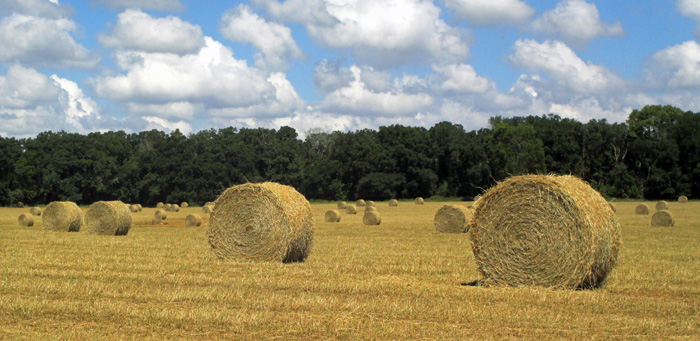
There were 185 entries in the 2014 Southeastern Hay Contest. Not only were there more samples sent in this year, but thanks to more favorable weather, the quality of the samples was better as well. Photo credit: Doug Mayo
Dennis Hancock, UGA Forage Extension Specialist and SE Hay Contest Coordinator

What is Relative Forage Quality (RFQ)?
In the past, hay quality prediction equations were based on the fiber concentration of the hay crop. However, forage crops can have similar fiber content yet have very different digestibility. For instance, Tifton 85 bermudagrass often has a higher fiber concentration than other bermudagrass varieties, yet it is more digestible. This improved digestibility results in enhanced animal performance, but is not reflected using traditional forage testing methods. The Relative Forage Quality index was developed by the University of Florida and the University of Wisconsin to predict the fiber digestibility and animal intake of harvested crops. Since 2003, hundreds of warm season samples have been used to refine the RFQ equation for bermudagrass and other warm season forages. Currently, all forage sample results from the UGA Feed and Forage Testing Lab in Athens contain an estimate of Relative Forage Quality. This value is a single, easy to interpret number that improves producer understanding of a forage’s nutritive quality and helps in establishing a fair market value for the product.
How can Relative Forage Quality help me?
Relative Forage Quality allows hay producers to easily categorize and price hay lots based on relative quality. Producers can purchase hay lots depending on its end use. For example there is little need to feed high-quality hay to livestock that could easily utilize poorer quality forage. Hay with a RFQ of 115-130 can be fed to maintain beef cow-calf pairs, hay with an RFQ of 125-150 is adequate for stocker cattle or young growing replacement heifers, and hay with an RFQ of 140-160 is suitable for dairy cattle in the first three months of lactation. It is also easy to see that Relative Forage Quality could provide the framework for a quality hay marketing system. For example, hay with a RFQ of 155 could conceptually be labeled “premium” hay, while hay with an RFQ of 105 could be labeled “fair”. This simple system could allow producers to price hay consistently and fairly across harvest maturity, fertilization regimes, or plant species (i.e. bermudagrass, bahiagrass, perennial peanut, or tall fescue).
- Northwest Florida Beef Cattle Conference & Trade Show – February 11 - December 19, 2025
- Friday Feature:The Sears Catalog –How Rural America Shopped before the Internet - December 19, 2025
- November 2025 Weather Summary & Winter Outlook - December 5, 2025
